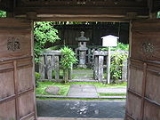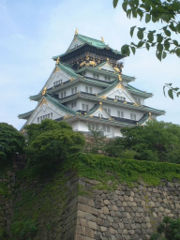
Hosokawa Gracia
Encyclopedia

, usually referred to as , (1563 – August 25 (17th day of the 7th month by the Japanese calendar
Japanese calendar
On January 1, 1873, Japan adopted the Gregorian calendar. Before 1873, the Chinese style lunisolar calendar had been in use since 7th century. Japanese eras are still in use.-System:...
), 1600) was a Christian convert, a daughter of Akechi Mitsuhide
Akechi Mitsuhide
, nicknamed Jūbei or called from his clan name and title, was a samurai who lived during the Sengoku period of Feudal Japan.Mitsuhide was a general under daimyo Oda Nobunaga, although he became infamous for his betrayal in 1582, which led to Nobunaga's death at Honno-ji...
and the wife of Hosokawa Tadaoki
Hosokawa Tadaoki
was the eldest son of Hosokawa Fujitaka. He fought in his first battle at the age of 15. In that battle, he was in the service of Oda Nobunaga. He was given the Province of Tango in 1580. Soon after that, he married Hosokawa Gracia, the daughter of Akechi Mitsuhide. In 1582, Akechi Mitsuhide...
.
She was named Tama at birth; Garasha, the name she is known by in history, is taken from her baptism
Baptism
In Christianity, baptism is for the majority the rite of admission , almost invariably with the use of water, into the Christian Church generally and also membership of a particular church tradition...
al name, Gracia.
She married Hosokawa Tadaoki
Hosokawa Tadaoki
was the eldest son of Hosokawa Fujitaka. He fought in his first battle at the age of 15. In that battle, he was in the service of Oda Nobunaga. He was given the Province of Tango in 1580. Soon after that, he married Hosokawa Gracia, the daughter of Akechi Mitsuhide. In 1582, Akechi Mitsuhide...
at the age of fifteen; the couple had five or six children. In the Sixth Month of 1582, her father Akechi Mitsuhide
Akechi Mitsuhide
, nicknamed Jūbei or called from his clan name and title, was a samurai who lived during the Sengoku period of Feudal Japan.Mitsuhide was a general under daimyo Oda Nobunaga, although he became infamous for his betrayal in 1582, which led to Nobunaga's death at Honno-ji...
betrayed and killed his lord, Oda Nobunaga
Oda Nobunaga
was the initiator of the unification of Japan under the shogunate in the late 16th century, which ruled Japan until the Meiji Restoration in 1868. He was also a major daimyo during the Sengoku period of Japanese history. His opus was continued, completed and finalized by his successors Toyotomi...
making her a traitor's daughter. Not wishing to divorce her, Tadaoki sent her to the hamlet of Midono in the mountains of the Tango Peninsula (now in Kyoto Prefecture
Kyoto Prefecture
is a prefecture of Japan located in the Kansai region of the island of Honshu. The capital is the city of Kyoto.- History :Until the Meiji Restoration, the area of Kyoto prefecture was known as Yamashiro....
), where she remained hidden until 1584. Tadaoki then took Tama to the Hosokawa mansion in Osaka, where she remained in confinement.
Tama's maid was from a Christian
Christianity
Christianity is a monotheistic religion based on the life and teachings of Jesus as presented in canonical gospels and other New Testament writings...
family, and her husband repeated to her conversations with his Christian friend Takayama Ukon. In the spring of 1587 Tama managed to secretly visit the Osaka church, and a few months later when she heard that Toyotomi Hideyoshi
Toyotomi Hideyoshi
was a daimyo warrior, general and politician of the Sengoku period. He unified the political factions of Japan. He succeeded his former liege lord, Oda Nobunaga, and brought an end to the Sengoku period. The period of his rule is often called the Momoyama period, named after Hideyoshi's castle...
had issued a proclamation against Christianity, she was determined to be baptized immediately. As she could not leave the house, she was baptized by her maid and received the Christian name "Gracia".
In 1595 Tadaoki's life was in danger because of his friendship with Toyotomi Hidetsugu
Toyotomi Hidetsugu
was a nephew and retainer of Toyotomi Hideyoshi who lived during the Sengoku period of the 16th century of Japan.A practitioner of the shudō tradition, Hidetsugu had a number of Wakashū...
, and he told Gracia that if he should die she must kill herself, but when she wrote asking the priests about it, they informed her that suicide is a grave sin. However, the danger passed.

Tokugawa Ieyasu
was the founder and first shogun of the Tokugawa shogunate of Japan , which ruled from the Battle of Sekigahara in 1600 until the Meiji Restoration in 1868. Ieyasu seized power in 1600, received appointment as shogun in 1603, abdicated from office in 1605, but...
in the east and Ishida Mitsunari
Ishida Mitsunari
Ishida Mitsunari was a samurai who led the Western army in the Battle of Sekigahara following the Azuchi-Momoyama period of the 17th century. Also known by his court title, Jibunoshō...
in the west. When Ieyasu went to the east in 1600 leading a large army, including Tadaoki, Ishida took over the impregnable castle in Osaka
Osaka Castle
is a Japanese castle in Chūō-ku, Osaka, Japan.Originally called Ozakajō, it is one of Japan's most famous castles, and played a major role in the unification of Japan during the sixteenth century of the Azuchi-Momoyama period.-Description:...
, the city where the families of many of Hideyoshi's generals resided. Ishida devised a plan to take the family members hostage, thus forcing the rival generals either to ally with him or at least not to attack him.
However, when Ishida attempted to take Gracia hostage, the family retainer Ogasawara Shōsai killed her; he and the rest of the household then committed seppuku
Seppuku
is a form of Japanese ritual suicide by disembowelment. Seppuku was originally reserved only for samurai. Part of the samurai bushido honor code, seppuku was either used voluntarily by samurai to die with honor rather than fall into the hands of their enemies , or as a form of capital punishment...
and burned the mansion down. The outrage over her death was so great that Ishida was forced to abandon his plan.
Most Japanese accounts state that it was Gracia's idea to order Ogasawara to kill her. But according to the Jesuit account written right after her death, whenever Tadaoki left the mansion he would tell his retainers that if his wife's honor were ever in danger, they should kill her and then themselves. They decided that this was such a situation; Gracia had anticipated it and accepted it.
A Catholic priest had Gracia's remains gathered from the Hosokawa mansion and buried them in a cemetery in Sakai
Sakai, Osaka
is a city in Osaka Prefecture, Japan. It has been one of the largest and most important seaports of Japan since the Medieval era.Following the February 2005 annexation of the town of Mihara, from Minamikawachi District, the city has grown further and is now the fourteenth most populous city in...
. Later, Tadaoki moved the remains to Sōkenji, a temple in Osaka.
Though popular culture
Popular culture
Popular culture is the totality of ideas, perspectives, attitudes, memes, images and other phenomena that are deemed preferred per an informal consensus within the mainstream of a given culture, especially Western culture of the early to mid 20th century and the emerging global mainstream of the...
states that the Vatican
Holy See
The Holy See is the episcopal jurisdiction of the Catholic Church in Rome, in which its Bishop is commonly known as the Pope. It is the preeminent episcopal see of the Catholic Church, forming the central government of the Church. As such, diplomatically, and in other spheres the Holy See acts and...
canonized
Canonization
Canonization is the act by which a Christian church declares a deceased person to be a saint, upon which declaration the person is included in the canon, or list, of recognized saints. Originally, individuals were recognized as saints without any formal process...
her as a saint in 1862, there are no historical documents that prove this.
Gracia in historical fiction
Gracia frequently appears as a character in Japanese historical fiction, both novels and drama. One website lists her as a character in over 40 stage dramas, movies, TV dramas, etc., from 1887 to 2006. She is also frequently referred to in popular writing or talks on the history of the period. A work that has been translated into English is Ayako MiuraAyako Miura
' was a Japanese novelist. She published over eighty works of both fiction and non-fiction. Many of her works are considered best-sellers, and a number have been remade as feature-length films....
's novel, Hosokawa Garasha Fujin (English title: Lady Gracia: a Samurai Wife's Love, Strife and Faith), which follows history fairly closely.
James Clavell
James Clavell
James Clavell, born Charles Edmund DuMaresq Clavell was an Australian-born, British novelist, screenwriter, director and World War II veteran and prisoner of war...
used Gracia as the model for the character of Mariko in his novel Shōgun
Shogun (novel)
Shōgun is a 1975 novel by James Clavell. It is the first novel of the author's Asian Saga. A major bestseller, by 1990 the book had sold 15 million copies worldwide...
. Additionally Clavell gave the Japanese wife of Vasco Rodrigues (whose Japanese name was Nyan-nyan ) the baptismal name Gracia. This book was later adapted for television as a miniseries
Shogun (TV miniseries)
Shōgun is an American television miniseries based on the namesake novel by James Clavell. As with the novel, the title is often shown as Shōgun in order to conform to Hepburn romanization. The miniseries was broadcast over five nights, between September 15 and September 19, 1980 on NBC in the...
. Elements of Mariko's story follows Gracia's quite closely, although the manner of her death is different and the two characters do not fundamentally have anything in common.

